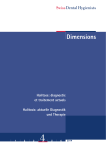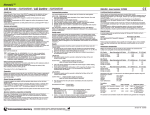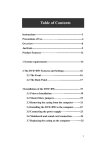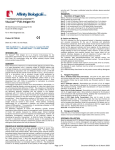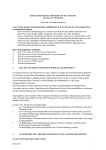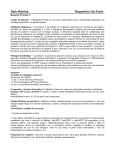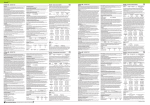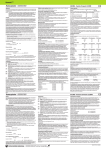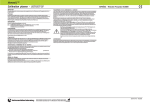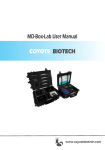Download ThromboPath - 0020005500 HemosIL® ThromboPath
Transcript
HemosIL® ThromboPath - 0020005500 ENGLISH - Insert revision 12/2008 Intended Use Instrument/Test Procedures Performance characteristics HemosIL ThromboPath (ThP) is an automated chromogenic assay for the functional evaluation of the Protein C anticoagulant pathway in human citrated plasma on the IL Coagulation Systems. The assay is intended as an aid in the diagnosis of thrombophilic defects such as Protein S (PS), Protein C (PC) deficiencies, Factor V Leiden (FVL) and Lupus Anticoagulants (LA). Refer to the appropriate IL instrument’s Operator’s Manual and/or Application Manual. Precision: Within run and total (run to run and day to day) precision was assessed over multiple runs using both normal and abnormal control samples. ACL 8/9/10000 Mean (PiCi%) CV % (Within run) CV % (Total) Normal Control plasma 81.8 0.61 1.55 Low Control plasma 67.6 1.97 3.02 ACL Futura/ACL Advance Mean (PiCi%) CV % (Within run) CV % (Total) Normal Control plasma 80.7 0.78 1.36 Low Control plasma 68.8 1.80 2.59 Summary and Principle The Protein C anticoagulation pathway is one of the most important mechanisms of regulation of coagulation. In vivo, thrombin bound to the receptor thrombomodulin activates Protein C to Activated Protein C (APC). In turn APC degrades the pro-coagulant factors FVa and FVIIIa, and this action is potentiated in the presence of the APC co-factors, Protein S, Factor V, and phospholipids. HemosIL ThromboPath determines the dysfunction of the anticoagulant Protein C pathway by measuring the endogenous Thrombin generation as Protac-induced Coagulation Inhibition Percent (PiCi%). During the assay, the plasma sample is diluted with ThP Diluent and tested as two separate aliquots. One aliquot is incubated with ThP Activator A (with Protac) and the other aliquot is incubated with ThP Activator B (without Protac). Thrombin generation in both aliquots is started by the addition of ThP Thromboplastin. Thrombin activity is quantified after addition of ThP Chromogenic Substrate by an increase in optical density at 405nm. The final result of the assay is calculated as PiCi% = ((OD with Activator B - OD with Activator A) / (OD with Activator B)) x 100. A cut-off can be determined for each instrument platform. Below the cut-off, samples may be pathologic for either PC, PS or APC Resistance and Lupus Anticoagulants. Composition The ThromboPath kit consists of: D ThP Diluent (P/N 0020005521): 2 x 10 mL vials of a liquid preparation containing HEPES buffer, polybrene, bulking agent and preservatives. S ThP Substrate (P/N 0020005522): 1 x 8 mL vials of a lyophilized preparation containing chromogenic substrate S-2796 Z-D-Arg-Sar-Arg-pNA.2HCL 1.46g/L with bulking agent. T ThP Thromboplastin (P/N 0020005523): 2 x 4 mL vials of lyophilized PT reagent containing HEPES buffer, Tissue Factor, synthetic phospholipids, calcium, magnesium, manganese, bulking agents and preservatives. A ThP Activator A (P/N 0020005524): 1 x 5 mL vial of lyophilized protein C activator fraction from the venom of Agkistrodon contortrix contortrix (Protac®) with bulking agent and preservative. B ThP Activator B (P/N 0020005525): 1 x 5 mL vials of lyophilized activator B without Protac and with bulking agent and preservative. L Low Control Plasma (P/N 0020005526): 2 x 1 mL vials of lyophilized human plasma containing a low level of Protein S. PRECAUTIONS AND WARNINGS: The materials in this product were tested by FDA approved methods and found nonreactive for Hepatitis B Surface Antigen (HBsAg), Anti-HCV and HIV antibodies. Handle as if potential infectious 1 Avoid contact with skin and eyes (S 24/25). Do not empty into drains (S 29). Wear suitable protective clothing (S 36). This product is for in vitro Diagnostic Use. Preparation ThP Diluent: Ready to use, invert to mix before use. ThP Substrate: Dissolve the contents with 8 mL of CLSI (formerly NCCLS) type II water or equivelant.2 Replace the stopper and swirl gently. Make sure of the complete reconstitution of product. Keep the reagents at 15-25°C for 30 minutes and invert to mix before use. Do not shake. ThP Thromboplastin: Dissolve the contents with 4 mL of CLSI type II water or equivalent.2 Replace the stopper and swirl gently. Make sure of the complete reconstitution of product. Keep the reagents at 15-25°C for 30 minutes and invert to mix before use. Do not shake. ThP Activator A: Dissolve the contents with 5 mL of CLSI type II water or equivalent. 2 Replace the stopper and swirl gently. Make sure of the complete reconstitution of product. Keep the reagents at 15-25°C for 30 minutes and invert to mix before use. Do not shake. ThP Activator B: Dissolve the contents with 5 mL of CLSI type II water or equivalent. 2 Replace the stopper and swirl gently. Make sure of the complete reconstitution of product. Keep the reagents at 15-25°C for 30 minutes and invert to mix before use. Do not shake ThP Low Control Plasma: Dissolve the contents with 1 mL of CLSI type II water or equivalent. 2 Replace the stopper and swirl gently. Make sure of the complete reconstitution of product. Keep the reagents at 15-25°C for 30 minutes and invert to mix before use. Do not shake. Reagent Storage and Stability Unopened reagents are stable until the expiration date shown on the vial when stored at 2-8°C. ThP Diluent, ThP Substrate, ThP Activator A and B: Stability after reconstitution: 2 days at 2-8°C, 3 weeks at -20°C in the original vial or 32 hours at 15°C on ACL Futura/ACL Advance Systems and ACL 8000/9000/10000. No stirring is required. ThP Thromboplastin: Stability after reconstitution: 2 days at 2-8°C in the original vial, 32 hours at 15°C on ACL Futura/ACL Advance Systems and ACL 8000/9000/10000. No stirring is required. ThP Low Control Plasma: Stability after reconstitution: 4 hours at 15-25°C in the sample cup, or 7 days at - 20°C in the original vial. For optimal stability remove reagents from the system and store them at 2-8°C in the original vial. Specimen Collection and Preparation Nine parts of freshly drawn venous blood are collected into one part tri-sodium citrate. Refer to CLSI Document H21-A4 for further instructions on specimen collection, handling and storage.3 Additional Reagents and Control Plasmas The following are not supplied with the kit and must be purchased separately. Americas and Pacific Rim Europe Cat. No. Cat. No. Normal Control 0020003120 0020003110 Quality Control Normal and low controls are recommended for a complete quality control program.4 Normal Control sold separately and the ThP Low Control Plasma included in this kit is designed to be part of this program. Each laboratory should establish its own mean and standard deviation and should establish a quality control program to monitor laboratory testing. Controls should be analyzed at least once every 8 hour shift in accordance with good laboratory practice. Refer to the instrument’s Operator’s Manual for additional information. Refer to Westgard et al for identification and resolution of out-of-control situtations.5 The Low Control plasma will give results less than 75 PiCi% and will be at a minimum 8 PiCi% lower than the Normal Control plasma. Results The following procedure should be used to calculate the PiCi% (OD with Activator B – OD with Activator A) PiCi% = ———————————————————— x 100 (OD with Activator B) See PiCi% Cut-off section for instructions on result interpretation. Limitations/Interfering Substances ThromboPath results are not affected by hemoglobin up to 100 mg/dL, bilirubin up to 20 mg/dL, triglycerides up to 700 mg/dL, Heparin up to 0.75 U/mL (UFH and LMWH), FVII or FVIIa up to 2.0 U/mL, FVIII up to 0.5U/mL and contact activation. High concentrations of FII, FVII, FVIIa, FX, LA and late pregnancy could decrease PiCi% values. Likewise low concentrations of FII, FVIII and FX can increase PiCi% values. Correlation: Three studies were performed on various instruments. A cut-off was performed for each study and the respective sensitivity and specificity determined. 6-10 An in-house study of 267 (126 normals/141 abnormals) was performed, using ThromboPath to screen citrated plasma samples with known deficiencies Protein S, C, APC R V and Lupus Anticoagulant on an ACL Advance. The abnormal samples were identified using Instrumentation Laboratory’s assays. Cut-off 80.9% Sensitivity = 98% Normal PS Def PC Def PS & PC Def FV Leiden L.A. No. Samples False Positive False Negative 126 11 14 35 44 34 14% 0 0 0 0 0 0 0 0 0 2.5% 0 A second study of 125 (40 Normals/85 abnormals) was performed in an external laboratory using ThromboPath to screen citrated plasma samples with known deficiencies of Protein S, C, APC R V and Lupus Anticoagulant on an ACL 9000. The abnormal samples were identified using Instrumentation Laboratory’s assays. Cut-off = 85.4% PiCi% Cut-Off Thrombophillic defects in the Protein C Pathway may be evident when the PiCi% is equal to or below the cut-off. When using the HemosIL ThromboPath kit, a cut-off must be established for each individual instrument and for each specific lot of HemosIL ThromboPath used. NOTE: The citrate concentration of the samples should equal that with which the cut-off was established. (3.2 Or 3.8% citrate) Procedure to establish the cut-off PiCi% value 1. For each new lot of ThromboPath, a new normal range should be established. 2. Use 30 local normal healthy individuals comprised equally of males and females between the ages of 20 – 65 years of age. Perform testing. 3. Calculate the mean and standard deviation in PiCi%. 4. The cut-off is equal to the Mean minus one Standard Deviation. 5. The ThP Low Control Plasma should be lower than the established cut-off. 6. The Normal Control Plasma will be higher than the low control and near the established cut-off. Specificity = 86% Study 1 Sensitivity = 91.7% Specificity = 85% Study 2 Normal PS Def PC Def PS & PC Def FV Leiden L.A. No. Samples False Positive False Negative 40 26 19 8 22 10 15% 0 0 0 0 0 0 23% 5.3% 0 0 0 A third study of 133 samples ( 102 normals / 31 abnormals ) was performed in an external laboratory using ThromboPath to screen citrated plasma samples with known deficiencies of Protein S, C, and APC R V on an ACL 9000. The abnormal samples were identified using Instrumentation Laboratory’s assays. Cut-off = 86.25% Sensitivity = 90.3% Specificity = 94.1% Interpretation The cut-off PiCi% value must be established for each instrument platform locally by customers with each new ThromboPath lot as defined above. Below the cut-off, samples may be pathologic for PC, PS or APC Resistance and Lupus Anticoagulants. The established cut-off should be a point below which APCR-V-heterozygous samples, and samples with PC < 70% and PS<60% fall. Samples with Protein C, Protein S deficiencies, FV Leiden or Lupus Anticoagulants may present a decreased PiCi% activity. In limited studies, results from pregnant women ran below the PiCi% cut-off range. Females had a lower mean PiCi% by 4.2% than men. Separate cut-off values for males and females could be used. The number of samples (n) should equal 30 when establishing gender-based cut-offs. Expected Values Study 3 Normal PS Def PC Def PS & PC Def FV Leiden L.A. No. Samples False Positive False Negative 102 18 7 1 5 0 5.9% 0 0 0 0 - 0 11.1% 14.2% 0 0 - The precision and correlation results were obtained using specific lots of reagents and controls. A cut-off was performed using the ThP kit on IL Coagulation systems. System N Mean minus 1 Standard Deviation ACL 8000/9000/10000 126 81.0 PiCi% ACL Futura/Advance 126 80.6 PiCi% In an additional study using 30 normal patient samples, the following results were obtained to conclude that the establishment of a cut-off based on a normal population sample set of 30 is acceptable. System N Mean minus 1 Standard Deviation ACL 8000/9000/10000 30 81.1 PiCi% ACL Futura/ Advance 30 80.9 PiCi% These results were obtained using a specific lot of reagent. Due to many variables, which may affect clotting times, each laboratory should establish its own normal range and cut-off. ThromboPath - 0020005500 DEUTSCH - Packungsbeilage Version 12/2008 HemosIL ThromboPath (ThP) ist ein vollautomatischer chromogener Test zur funktionellen Erfassung des gesamten antikoagulatorischen Protein C Systems in humanem Citratplasma auf IL-Analysensystemen. Der Test dient als Unterstützung der Diagnose von thrombophilen Defekten wie Protein S- (PS), Protein C-Mangel (PC), Faktor V Leiden (FVL) und Lupus-Antikoagulantien (LA). ThP Low Control Plasma - Haltbarkeit nach Rekonstitution: - bei 15-25°C in einem Probencup: 4 Stunden - bei -20°C in der Originalflasche: 7 Tage Für eine optimale Haltbarkeit sollten die Reagenzien nach dem Gebrauch aus dem Gerät entnommen und im Kühlschrank bei 2-8°C in der Originalflasche aufbewahrt werden. Testprinzip und Zusammenfassung Bestimmungsansatz Das antikoagulatorische Protein C System ist eines der wichtigsten Mechanismen zur Regulation der Gerinnung. Das an den Rezeptor Thrombomodulin gebundene Thrombin aktiviert in vivo Protein C zu aktiviertem Protein C (APC). Daraufhin baut das APC die prokoagulatorischen Faktoren FVa und FVIIIa ab. Diese Reaktion wird verstärkt durch die Anwesenheit der APC-Kofaktoren, Protein S und Faktor V, sowie Phospholipide. Der HemosIL ThromboPath Test bestimmt die Fehlfunktion des antikoagulatorischen Protein C Systems, indem er die endogene Thrombinbildung als Prozent der Protacinduzierten Protein C-Inhibition (PiCi%) misst. Im vorliegenden Test wird das Patientenplasma mit ThP Diluent verdünnt und in zwei verschiedenen Ansätzen gemessen. Ein Ansatz wird mit ThP Aktivator A (enthält Protac), der zweite Ansatz mit ThP Aktivator B (kein Protac) inkubiert. Die Thrombinbildung wird in beiden Fällen durch die Zugabe von ThP Thromboplastin gestartet. Nach der Zugabe des ThP Chromogenen Substrates wird die Thrombinaktivität durch den Anstieg der optischen Dichte (OD) bei 405 nm gemessen. Das Endergebnis des Testes wird berechnet als PiCi% = ((OD mit Aktivator B - OD mit Aktivator A) / (OD mit Aktivator B))* 100. Es sollte ein Cut-Off-Wert für jede Gerätelinie bestimmt werden. Ergebnisse unterhalb des Cut-Off-Wertes sind als pathologisch für Protein C, Protein S oder APC Resistenz und Lupus Antikoagulantien zu betrachten. Die ausführliche Beschreibung des Bestimmungsansatzes ist dem GeräteBedienerhandbuch und/oder dem Applikationshandbuch zu entnehmen. Verwendung Inhalt Die ThromboPath Packung enthält: D ThP Diluent (Art. Nr. 0020005521): 2 Flaschen x 10 mL mit HEPES-Puffer, der Polybren, Füllmaterialien und Konservierungsmittel enthält. S ThP Substrate (Art. Nr. 0020005522): 1 Flasche x 8 mL eines lyophilisierten chromogenen Substrates: S-2796 Z-D-Arg-Sar-Arg-pNA.2HCL 1.46 g/L mit Füllmaterialien. T ThP Thromboplastin (Art. Nr. 0020005523): 2 Flaschen x 4 mL lyophilisiertes PT Reagenz, das HEPES-Puffer, Gewebefaktor, synthetische Phospholipide, Kalzium, Magnesium, Mangan, Füllmaterialien und Konservierungsmittel enthält. A ThP Activator A (Art. Nr. 0020005524): 1 Flasche x 5 mL lyophilisierte Protein C Aktivator-Fraktion aus dem Gift der Kupferkopfschlange (Protac®), das Füllmaterialien und Konservierungsmittel enthält. B ThP Activator B (Art. Nr. 0020005525): 1 Flasche x 5 mL lyophilisierter Aktivator B ohne Protac, der Füllmaterialien und Konservierungsmittel enthält. L Low Control Plasma (Art. Nr. 0020005526): 2 Flaschen x 1 mL lyophilisiertes Humanplasma mit einer niedrigen Protein S-Konzentration. WARNUNG: Das verwendete Material wurde mit FDA-anerkannten Testmethoden auf HIVAntikörper, Hepatitis-B-Antigen und HCV-Antigen geprüft. Bitte beachten Sie die Bestimmungen zum Umgang mit potentiell infektiösen Materialien.1 Berührung mit den Augen und der Haut vermeiden (S 24/25). Nicht in die Kanalisation gelangen lassen (S 29). Bei der Arbeit geeignete Schutzkleidung tragen (S 36). Dieses Produkt ist nur für die in vitro Diagnostik geeignet. Herstellung ThP Diluent: Gebrauchsfertig. Vor dem Gebrauch vorsichtig schwenken. ThP Substrate: Inhalt der Flasche mit 8 mL Aqua dest. lösen.2 Dann die Flasche verschließen und durch leichtes Schwenken das Lyophilisat lösen. Nach vollständiger Rekonstitution wird das Reagenz 30 Minuten bei 15-25°C inkubiert und unter vorsichtigem Schwenken erneut gemischt. Nicht schütteln. ThP Thromboplastin: Inhalt der Flasche mit 4 mL Aqua dest. lösen.2 Dann die Flasche verschließen und durch leichtes Schwenken das Lyophilisat lösen. Nach vollständiger Rekonstitution wird das Reagenz 30 Minuten bei 15-25°C inkubiert und unter vorsichtigem Schwenken erneut gemischt. Nicht schütteln. ThP Activator A: Inhalt der Flasche mit 5 mL Aqua dest. lösen.2 Dann die Flasche verschließen und durch leichtes Schwenken das Lyophilisat lösen. Nach vollständiger Rekonstitution wird das Reagenz 30 Minuten bei 15-25°C inkubiert und unter vorsichtigem Schwenken erneut gemischt. Nicht schütteln. ThP Activator B: Inhalt der Flasche mit 5 mL Aqua dest. lösen.2 Dann die Flasche verschließen und durch leichtes Schwenken das Lyophilisat lösen. Nach vollständiger Rekonstitution wird das Reagenz 30 Minuten bei 15-25°C inkubiert und unter vorsichtigem Schwenken erneut gemischt. Nicht schütteln. ThP Low Control Plasma: Inhalt der Flasche mit 1 mL Aqua dest. lösen. 2 Dann die Flasche verschließen und durch leichtes Schwenken das Lyophilisat lösen. Nach vollständiger Rekonstitution wird das Reagenz 30 Minuten bei 15-25°C inkubiert und unter vorsichtigem Schwenken erneut gemischt. Nicht schütteln. Lagerung und Haltbarkeit Die ungeöffneten Reagenzien sind bei Lagerung von 2-8°C bis zu dem auf dem Etikett angegebenen Verfallsdatum haltbar. ThP Diluent, ThP Substrate, ThP Activator A und B Haltbarkeit nach Rekonstitution in ACL 8000/9000/10000 und ACL Futura/ACL Advance-Systemen: - bei 2-8°C in der Originalflasche: 2 Tage - bei 15°C im Gerät: 32 Stunden - bei -20°C in der Originalflasche: 3 Wochen Muss nicht gerührt werden. Probenmaterial - Antikoaguliertes Plasma 9 Teile frisches venöses Blut und 1 Teil Trinatriumcitratlösung werden sorgfältig in einem silikonisierten Glasröhrchen gemischt. Hinweise zur Aufbereitung des Blutes sind den Empfehlungen des Deutschen Instituts für Normung - DIN 58 905 - oder dem CLSI Dokument H21-A4 zu entnehmen.3 Zusätzliche Reagenzien und Kontrollplasmen Die folgenden Reagenzien sind nicht in der Packung enthalten und müssen zusätzlich bestellt werden: Amerikan. und Pazifischer Raum Europa Art. Nr. Art. Nr. Normal-Kontroll-Plasma 0020003120 0020003110 Qualitätskontrolle Es ist gängige Laborpraxis, die Qualität der Analyse mit Kontrollmaterialien im normalen sowie im pathologischen Bereich zu überprüfen.4 Es wird empfohlen, als Kontrollmaterial die oben angegebene Normalkontrolle und die ThP Kontrolle (niedriger Bereich), die in der Packung enthalten ist, zu verwenden. Jedes Labor sollte jedoch für das Qualitätskontroll-Programm seinen eigenen Kontrollbereich ermitteln. Spätestens nach jeweils 8 Stunden sollte eine Qualitätskontrolle durchgeführt werden. Algorithmen zur Beurteilung der Qualitätskontrollergebnisse siehe z.B. Westgard et al.5 Siehe auch “Richtlinien der Bundesärztekammer zur Qualitätssicherung quantitativer laboratoriumsmedizinischer Untersuchungen” in der jeweils gültigen Ausgabe. Die Kontrolle im niedrigen Bereich liegt bei < 75 PiCi% und ist wenigstens 8 PiCi% niedriger als die Normalkontrolle. Ergebnisse Die folgende Formel wird zur Berechnung der PiCi% herangezogen: (OD mit Aktivator B – OD mit Aktivator A) PiCi% = ——————————————————— x 100 (OD mit Aktivator B) Zur Interpretation der Ergebnisse beachten Sie bitte auch den Abschnitt PiCi% Cut-Off. Referenzbereiche Mit dem ThP Kit wurde der Cut-Off-Wert auf IL Gerinnungssystemen bestimmt. System N Mittelwert minus 1s (Standardabweichung) ACL 8000/9000/10000 126 81.0 PiCi% ACL Futura/ACL Advance 126 80.6 PiCi% In einer zweiten Studie wurde unter Verwendung von 30 Normalpatienten bestätigt, dass die Anzahl 30 ausreichend ist für die Ermittlung eines zuverlässigen Cut-Off-Wertes. System ACL 8000/9000/10000 ACL Futura/ACL Advance ThromboPath Ergebnisse werden durch Konzentrationen an Hämoglobin bis zu 100 mg/dL, Bilirubin bis zu 20 mg/dL, Triglyceriden bis zu 700 mg/dL, Heparin (unfraktionierte oder niedermolekulare Heparine) bis zu 0,75 U/mL, FVII oder FVIIa bis zu 2,0 U/mL, FVIII bis zu 0,5 U/mL und Kontaktaktivierung nicht beeinflusst. Hohe Konzentrationen von FII, FVII, FVIIa, FX, LA und vorangeschrittene Schwangerschaft können die PiCi%-Ergebnisse erniedrigen. Ebenso können niedrige Konzentrationen von FII, FVIII und FX die PiCi%-Ergebnisse erhöhen. PiCi% Cut-Off Thrombophile Defekte im antikoagulatorischen Protein C System können evident sein, wenn die PiCi% gleich oder unterhalb des Cut-Off-Wertes liegen. Bei Verwendung des HemosIL ThromboPath Testes muss ein Cut-Off-Wert für jedes verwendete Gerät und für jede neue Reagenzcharge des HemosIL ThromboPath ermittelt werden. BITTE BEACHTEN: Die Citrat-Konzentration der Proben, die zur Ermittlung des CutOff-Wertes eingesetzt wurde, muss identisch sein mit der Citrat-Konzentration der zu untersuchenden Patientenplasmen. (3,2 oder 3,8 % Citrat) Vorgehensweise zur Ermittlung des Cut-Off PiCi%-Wertes 1. Für jede neue Reagenzcharge des ThromboPath sollte ein neuer Normalbereich ermittelt werden. 2. Führen Sie den Test mit 30 gesunden Normalplasmen gleichermaßen bestehend aus männlichen und weiblichen Probanden im Alter von 20-65 Jahren durch. 3. Berechnen Sie Mittelwert und Standardabweichung in PiCi%. 4. Der Cut-Off-Wert entspricht dem Mittelwert minus der einfachen Standardabweichung. 5. Die ThP Kontrolle (niedriger Bereich) sollte unterhalb des ermittelten Cut-Off-Wertes liegen. 6. Die Normalkontrolle muss höher als die ThP Kontrolle (niedriger Bereich), etwa im Bereich des Cut-Off-Wertes liegen. Interpretation Bei Verwendung des HemosIL ThromboPath Testes muss ein Cut-Off-Wert für jedes verwendete Gerät und für jede neue Reagenzcharge des HemosIL ThromboPath kundenspezifisch ermittelt werden. Ergebnisse unterhalb des Cut-Off-Wertes sind als pathologisch für Protein C, Protein S oder APC Resistenz und Lupus Antikoagulantien zu betrachten. Der ermittelte Cut-Off-Wert sollte so liegen, dass heterozygote APCR-V Patienten und Proben mit PC < 70% und PS < 60% unterhalb dieses Wertes liegen. Patienten mit Protein C-, Protein S-Mangel, FV Leiden oder Lupus Antikoagulantien können eine verminderte PiCi%-Aktivität aufweisen. In limitierten Studien zeigten sich bei Schwangeren Ergebnisse unterhalb des PiCi% Cut-Off Bereiches. Bei Frauen ergaben sich um 4,2 % niedrigere Ergebnisse im Mittel als bei Männern. Geschlechtsabhängige Cut-Off-Werte können verwendet werden. Die Anzahl der Untersuchungen (n) sollte bei geschlechtsabhängigen Cut-OffWertermittlungen ebenfalls jeweils bei 30 liegen. ThP Thromboplastin Haltbarkeit nach Rekonstitution in ACL 8000/9000/10000 und ACL Futura/ACL Advance-Systemen: - bei 2-8°C in der Originalflasche: 2 Tage - bei 15°C im Gerät: 32 Stunden Muss nicht gerührt werden. Mittelwert minus 1s (Standardabweichung) 81.1 PiCi% 80.9 PiCi% Die Werte wurden mit einer spezifischen Reagenziencharge ermittelt. Aufgrund verschiedener Variablen, die die Ergebnisse beeinflussen können, wird empfohlen, dass jedes Labor seinen eigenen Normalbereich und Cut-Off-Wert ermittelt. Testcharakteristik Präzision: Die Präzision im Lauf und von Tag zu Tag wurde bei mehreren Läufen bestimmt. ACL 8/9/10000 Normal-Kontroll-Plasma Kontrollplasma (niedrig) Mittelwert (PiCi%) VK % (im Lauf) VK % (Tag zu Tag) 81.8 0.61 1.55 67.6 1.97 3.02 ACL Futura/ACL Advance Mittelwert (PiCi%) VK % (im Lauf) VK % (Tag zu Tag) Normal-Kontroll-Plasma 80.7 0.78 1.36 Kontrollplasma (niedrig) 68.8 1.80 2.59 Korrelation: Insgesamt wurden drei Studien an verschiedenen Geräten durchgeführt. Es wurden jeweils der Cut-Off-Wert und die entsprechende Sensitivität und Spezifität bestimmt.6-10 In einer inhouse-Studie mit 267 Citratplasmaproben (126 normale/141 abnormale) wurde der ThromboPath als Screening-Test bei bekanntem Protein C-, Protein SMangel, APCR-V und Lupus Antikoagulantien am ACL Advance durchgeführt. Die abnormalen Proben wurden unter Verwendung von IL-Testen identifiziert. Cut-Off 80.9% Einschränkungen N 30 30 Sensitivität = 98% Studie 1 Normal Anzahl Proben Falsch positiv Falsch negativ 126 Spezifität = 86% PS Mangel PC Mangel PS & PC Mangel FV Leiden LA 11 14 35 44 34 14% 0 0 0 0 0 0 0 0 0 2.5% 0 In einer zweiten externen Studie mit 125 Citratplasmaproben (40 normale/85 abnormale) wurde der ThromboPath als Screening-Test bei bekanntem Protein C-, Protein S-Mangel, APCR-V und Lupus Antikoagulantien am ACL 9000 durchgeführt. Die abnormalen Proben wurden unter Verwendung von IL-Testen identifiziert. Cut-Off = 85.4% Sensitivität = 91.7% Spezifität = 85% Studie 2 Normal Anzahl Proben Falsch positiv Falsch negativ 40 PS Mangel PC Mangel PS & PC Mangel FV Leiden LA 26 19 8 22 10 15% 0 0 0 0 0 0 23% 5.3% 0 0 0 In einer dritten externen Studie mit 133 Citratplasmaproben (102 normale/31 abnormale) wurde der ThromboPath als Screening-Test bei bekanntem Protein C-, Protein S-Mangel, APCR-V und Lupus Antikoagulantien am ACL 9000 durchgeführt. Die abnormalen Proben wurden unter Verwendung von IL-Testen identifiziert. Cut-Off = 86.25% Sensitivität = 90.3% Studie 3 Normal Anzahl Proben Falsch positiv Falsch negativ 102 Spezifität = 94.1% PS Mangel PC Mangel PS & PC Mangel FV Leiden LA 18 7 1 5 0 5.9% 0 0 0 0 - 0 11.1% 14.2% 0 0 - Die Ergebnisse sind mit spezifischen Reagenzien- und Kontrollchargen ermittelt worden. Bibliography / Literatur / Bibliografía / Bibliographie / Bibliografia /Bibliografia / Litteratur / Litteraturförteckning / 1. Richmond JY, McKinney RW eds. Biosafety in Microbiological and Biomedical Labs. U.S. Dept. of Health and Human Services, Public Health Service, 4th Edition, 1999. 2. National Committee for Clinical Laboratory Standards. Preparation and Testing of Reagent Water in the Clinical Laboratory, Third Edition, NCCLS Document C3-A3; Vol. 17 No. 18 3. National Committee for Clinical Laboratory Standards. Collection, Transport and Processing of Blood Specimens for Testing Plasma-Based Coagulation Assays, Fourth Edition, NCCLS Document H21-A4; Vol. 23 No. 35 4. Zucker S, Cathey MH, West B. Preparation of Quality Control Specimen for coagulation, Am. J. Clin. Pathol. 1970; 63: 924-927 5. Westgard JO, and Barry PL. Cost-Effective Quality Control; Managing the Quality and Productivity of Analytical Process, AACC Press 1986. 6. Safa O, Smirnov M, Diaz DE, Triscott M, Toulon P, Tripodi A. HemosIL ThromboPath: A Chromogenic Assay Sensitive t Major Prothrombotic Risk Factors Affecting the Protein C Pathway, Journal of Thrombosis and Haemostasis 2005; Volume 3, Supplement 1:OR082 7. Toulon, PA, Bouziane K. Analytical Performances of a New Screening Assay to evaluate the Functionality of the Protein C Anticoagulant Pathway, and Effect of Pre-Analytical variables on the test Result, Journal of Thrombosis and Haemostasis 2005; Volume 3, Supplement 1:P0694 8. Toulon PA. Usefulness of a New ASSAY for Protein C Anticoagulant Pathway, ISLH, San Francisco, May 11 – 14, 2005 9. Toulon PA, Rosencher N, Guigon Aurelie, Simon A. Sensitivity of a New Global Assay for Protein C (PC) Pathway abnormalities and Potential Significance of Abnormal Test results as a Risk Factor/Marker for Thrombosis Independently of Its Sensitivity for PC Pathway Abnormalities. ASH, Atlanta Dec. 10 – 13, 2005 10. Smirnov M, Safa O, Thomas E, Lawson D. New Chromogenic Screening Assay for detecting deficiencies in Protein C and Protein S. Journal of Thrombosis and Haemostasis 2003; 1 Supplement 1 July: P0016 ACL and ACL Futura are trademarks of Instrumentation Laboratory Protac® is a registered trademark of Pentapharm Ltd. ®2005 Instrumentation Laboratory. Issued December 2008 Symbols used / Verwendete Symbole / Símbolos utilizados / Symboles utilisés / Simboli impiegati / Símbolos utilizados / Anvendte symboler / Använda Symboler / In vitro diagnostic medical device In-vitro Diagnostikum De uso diagnóstico in vitro Dispositif mèdical de diagnostic in vitro Per uso diagnostico in vitro Dispositivo médico para utilização em diagnóstico in vitro “in vitro” diagnostisk udstyr In vitro diagnostisk medicinsk produkt Batch code Chargen-Bezeichnung Identificación número de lote Désignation du lot Numero del lotto Número de lote Batch nr. Tillverkningskod Use by Verwendbar bis Caducidad Utilisable jusqu’à Da utilizzare prima del Data límite de utilização Anvendelse Användning Temperature limitation Festgelegte Temperatur Temperatura de Almacenamiento Températures limites de conservation Limiti di temperatura Límite de temperatura Temperatur begrænsninger Temperatur gräns Consult instructions for use Beilage beachten Consultar la metódica Lire le mode d’emploi Vedere istruzioni per l’uso Consultar as instruções de utilização Se vejledning for anvendelse Ta del av instruktionen före användning Control Kontrollen Control Contrôle Controllo Controlo Kontrol Kontroll Biological risks Biologisches Risiko Riesgo biológico Risque biologique Rischio biologico Risco biológico Miljø oplysninger Biologiska risker Manufacturer Hergestellt von Fabricado por Fabricant Prodotto da Fabricado por Producent Tillverkare Authorised representative Bevollmächtigter Representante autorizado Mandataire Rappresentanza autorizzata Representante autorizado Leverandør Auktoriserad representant In vitro Instrumentation Laboratory Company - Bedford, MA 01730-2443 (USA) Instrumentation Laboratory SpA - V.le Monza 338 - 20128 Milano (Italy) 303485A R1 12/2008 HemosIL® ThromboPath - 0020005500 ESPAÑOL - Revisión Prospecto 12/2008 Aplicación Reactivos Adicionales Plasmas de Control Características de rendimiento El HemosIL ThromboPath (ThP) es un ensayo cromogénico automatizado para la evaluación funcional del sistema de anticoagulación de la proteína C en plasma humano citratado en los Sistemas de Coagulación IL. El ensayo pretende ser una ayuda al diagnóstico de defectos trombofílicos como la deficiencia de Proteína S (PS), y Proteína C (PC), Factor V Leiden (FVL) y los Anticoagulantes Lúpicos (AL). Los siguientes elementos no se proporcionan junto al kit y deben adquirirse por separado. Las Américas y el Pacífico Europa Nº de Cat. Nº de Cat. Control Normal 0020003120 0020003110 Precisión: Se determinó la precisión intraensayo y total (ensayo a ensayo y día a día) a lo largo de diversos ensayos utilizando muestras de control normales y anormales. ACL 8/9/10000 Media (PiCi%) % CV (Intraserie) % CV (Total) Plasma Control Normal 81,8 0,61 1,55 Plasma Control Bajo 67,6 1,97 3,02 ACL Futura/ACL Advance Media (PiCi%) % CV (Intraserie) % CV (Total) Plasma Control Normal 80,7 0,78 1,36 Plasma Control Bajo 68,8 1,80 2,59 Principio del Método La ruta anticoagulante de la Proteína C es uno de los mecanismos mas importantes de regulación de la coagulación. “In vivo”, la Trombina unida al receptor Trombomodulina activa la Proteína C a Proteína C activada (APC). A continuación, la APC degrada los factores pro-coagulantes FVa y FVIIIa, degradación que se potencia en presencia de los cofactores de la APC: Proteína S, Factor V y fosfolípidos. HemosIL ThromboPath determina la disfunción de la ruta anticoagulante de la Proteína C midiendo la generación endógena de Trombina como Porcentaje de Inhibición de la Coagulación inducida por Protac (PiCi%). Durante el ensayo, la muestra de plasma se diluye con Diluyente ThP y se ensaya como dos alícuotas separadas. Una se incuba con Activador ThP A (con Protac) y la otra se incuba con Activador ThP B (sin Protac). La generación de Trombina en ambas alícuotas comienza cuando se adiciona ThP Thromboplastin. La actividad de la Trombina se cuantifica, después de la adición de Substrato Cromogénico ThP, mediante el incremento de la densidad óptica a 405nm. El resultado final del ensayo se calcula como PiCi% = ((DO con Activador B – DO con Activador A) / (DO con Activador B)) x 100. Para cada tipo de instrumento se establecerá un “cut-off”. Por debajo del “cut-off” las muestras pueden ser patológicas para PC, o PS, o Resistencia a APC y Anticoagulante lúpico. Composición El kit ThromboPath está formado por: D Diluyente ThP (P/N 0020005521): 2 viales de 10 ml de una preparación líquida que contiene tampón HEPES, polibreno, agente excipiente y conservantes. S Sustrato ThP (P/N) 0020005522): 1 vial de 8 ml de una preparación liofilizada que contiene sustrato cromogénico S-2796 Z-D-Arg-Sar-Arg-pNA.2HCL 1,46 g/L de agente excipiente. T Tromboplastina ThP (P/N) 0020005523): 2 viales de 4 ml de reactivo PT liofilizado con tampón HEPES, Factor Tisular, fosfolípidos sintéticos, calcio, magnesio, manganeso, agentes excipientes y conservantes. A Activador A de ThP (P/N 0020005524): 1 vial de 5 ml de fracción activadora de la Proteína C liofilizada procedente del veneno de Agkistrodon contortrix contortrix (Protac®) con agente excipiente y conservante. B Activador B de ThP (P/N 0020005525): 1 vial de 5 ml de activador B sin Protac y con agente excipiente y conservante. L Plasma Control Bajo (P/N 0020005526): 2 viales de 1 ml de plasma humano liofilizado con un nivel reducido de proteína S. PRECAUCIONES Y ADVERTENCIAS El material usado en este producto ha sido verificado mediante los métodos aprobados por la FDA y se ha encontrado que no resulta reactivo al Antígeno de Superficie de la Hepatitis B (HBsAg), Anti-HCV y anticuerpos HIV. Manejar con precaución como si fuera potencialmente infeccioso. Evite el contacto con los ojos y la piel (S 24/25). No deseche los residuos por el desagüe (S 29). Utilice indumentaria protectora adecuada (S 36). Este reactivo es para uso en diagnóstico in vitro. Preparación Diluyente ThP: Listo para su uso: mezclar por inversión del vial antes de su utilización. Sustrato ThP: Disuelva el contenido en 8 ml de agua CLSI (anteriormente NCCLS) de tipo II o equivalente.2 Tape el vial y mézclelo suavemente. Asegúrese de la reconstitución total del producto. Mantenga los reactivos a 15-25º C durante 30 minutos e inviértalos para su mezcla antes de utilizarlos. No lo agite. Tromboplastina ThP: Disuelva el contenido en 4 ml de agua CLSI de tipo II o equivalente.2 Tape el vial y mézclelo suavemente . Asegúrese que se produce la reconstitución total del producto. Mantenga los reactivos a 15-25º C durante 30 minutos e inviértalos para su mezcla antes de utilizarlos. No lo agite. Activador A de la ThP: Disuelva el contenido en 5 ml de agua CLSI de tipo II o equivalente.2 Tape el vial y mézclelo suavemente . Asegúrese que se produce la reconstitución total del producto. Mantenga los reactivos a 15-25º C durante 30 minutos e inviértalos para su mezcla antes de utilizarlos. No lo agite. Activador B de la ThP: Disuelva el contenido con 5 ml de agua CLSI de tipo II o equivalente.2 Tape el vial y mézclelo suavemente . Asegúrese que se produce la reconstitución total del producto. Mantenga los reactivos a 15-25º C durante 30 minutos e inviértalos para su mezcla antes de utilizarlos. No los agite. Plasma Control Bajo de la ThP: Disuelva el contenido con 1 ml de agua CLSI de tipo II o equivalente. 2 Tape el vial y mézclelo suavemente . Asegúrese que se produce la reconstitución total del producto. Mantenga los reactivos a 15-25º C durante 30 minutos e inviértalos para su mezcla antes de utilizarlos. No los agite. Conservación y Estabilidad de los reactivos Los reactivos no abiertos son estables hasta la fecha de caducidad indicada en el vial, si se almacenan entre 2-8°C. Diluyente ThP, Sustrato ThP, Activadores A y B ThP: Estabilidad después de la reconstitución: 2 días a 2-8 ºC, 3 semanas a -20ºC en el vial original o 32 horas a 15ºC en Sistemas ACL Futura/ACL Advance y ACL 8000/9000/10000. No se requiere agitación continuada. Tromboplastina ThP: Estabilidad después de la reconstitución: 2 días a 2-8ºC o 32 horas a 15ºC en Sistemas ACL Futura/ACL Advance y ACL 8000/9000/10000. No se requiere agitación continuada. Plasma Control Bajo ThP: Estabilidad después de la reconstitución: 4 horas a 1525ºC en un pocillo de muestra o 7 días a -20ºC si se almacena en el vial original. Para una estabilidad óptima retire los reactivos del sistema y almacénelos a 2-8ºC en el vial original. Control de Calidad Se recomienda la utilización de controles normales y bajos para obtener un programa de control de calidad completo.4 El Control Normal –vendido por separado- y el Plasma Control Bajo ThP –incluido en este kit- están diseñados para formar parte de este programa. Cada laboratorio debería establecer sus valores promedios y desviación estándar y un programa de control de calidad para controlar las pruebas del laboratorio. Los controles deberían ser analizados al menos una vez cada turno de 8 horas de acuerdo con buenas prácticas de laboratorio. Consulte el Manual de Funcionamiento del instrumento para más información. Consulte a Westgard et al para la identificación y resolución de situaciones fuera de control.5 El plasma de Control Bajo presentará unos resultados inferiores a 75 PiCi% y se será como mínimo un 8 PiCi% menor que el plasma Control Normal. Resultados Deberá utilizar el siguiente procedimiento para calcular el PiCi% PiCi% = (DO con Activador B – DO con Activador A) ———————————————————— x 100 (DO con Activador B) Consulte la sección Cut-off del PiCi% para instrucciones sobre la interpretación de los resultados. Limitaciones/Interferencias Los resultados del ThromboPath no se ven afectados por la hemoglobina hasta 100 mg/dl, bilirrubina hasta 20 mg/dl, triglicéridos hasta 700 mg/dl, Heparina hasta 0,75 U/ml (UFH y LMWH), FVII o FVIIa hasta 2,0 U/ml , FVIII hasta 0,5 U/ml y por la activación por contacto. Unas concentraciones elevadas de FII, FVII, FVIIa, FX, AL y una situación avanzada de gestación podrían hacer disminuir los valores de PiCi%. Asimismo, unas concentraciones reducidas de FII, FVIII y FX pueden aumentar los valores de PiCi%. Cut-Off PiCi% Los defectos trombofílicos en el sistema de la Proteína C pueden resultar evidentes cuando el PiCi% es igual o inferior al cut-off. Se debe establecer un valor de cut-off para cada instrumento y para cada lote específico de ThromboPath HemosIL. NOTA: La concentración de citrato de las muestras debe ser la misma utilizada para establecer el valor del cut-off (citrato de 3,2 o 3,8%). Procedimiento para establecer el cut-off PiCi% 1. Deberá establecerse un nuevo Rango Normal para cada nuevo lote de ThromboPath. 2. Utilice 30 individuos locales normales sanos. Escoja la misma proporción de hombres que mujeres con edades de 20-65 años. Realice el test. 3. Calcule la media y la Desviación Estándar en PiCi%. 4. El valor del cut-off es igual a la media menos una Desviación Estándar. 5. El Plasma Control Bajo ThP debe ser inferior que el cut-off establecido. 6. El Plasma Control Normal será superior al Control Bajo y cercano al cut-off. Interpretación El valor de cut-off de PiCi% de cada lote ThromboPath debe ser establecido localmente por los usuarios para cada familia de instrumentos, tal y como se describe arriba. Las muestras pueden resultar patológicas debido a PC, PS o Resistencia a la APC y anticoagulantes lúpicos si se encuentran por debajo del cut-off establecido. El cut-off establecido debe ser un punto por debajo del cual se sitúan muestras heterocigotas para la APCR-V y muestras con PC<70% y PS<60%. Las muestras con deficiencias de Proteína C y Proteína S, FV Leiden o Anticoagulantes lúpico pueden presentar una actividad PiCi% más reducida. En estudios concretos, los resultados procedentes de mujeres embarazadas se mantuvieron por debajo del cut-off de PiCi%. En mujeres se obtuvo un promedio de un 4,2 % de PiCi% inferior respecto a los hombres. Podrían utilizarse valores de cut-off distintos para la población masculina y femenina. La cantidad de muestras (n) debe ser de 30 si se desea establecer un cut-off basados en el género. Valores esperados Se determinó el cut-off utilizando el kit ThP en sistemas de Coagulación IL. Sistema N Media menos 1 Desviación Estándar ACL 8000/9000/10000 126 81,0 PiCi% ACL Futura/Advance 126 80,6 PiCi% En un estudio adicional utilizando 30 muestras de pacientes normales, se obtuvieron los siguientes resultados, concluyendo que resulta aceptable la fijación de un cut-off basado en un conjunto de 30 muestras de población normal. Correlación: Se realizaron tres estudios utilizando varios instrumentos. Se generó un cut-off para cada estudio y se determinó la sensibilidad y especificidad respectivas.6-10 Se realizó un estudio interno de 267 muestras (126 normales/141 anormales) utilizando ThromboPath en muestras de plasma citratado con deficiencias conocidas de Proteína S, C, APC R V y Anticoagulante lúpico utilizando un ACL Advance. Se identificaron las muestras anormales utilizando los ensayos de Instrumentation Laboratory. Cut-off = 80.9% Sensibilidad = 98% Especificidad = 86% Estudio 1 Normal Def de PS Def de PC N° de muestras Falsos positivos Falsos negativos 126 11 14 Def de PS & PC FV Leiden 35 A.L. 44 34 14% 0 0 0 0 0 0 0 0 0 2.5% 0 Se realizó un segundo estudio de 125 muestras (40 normales/85 anormales) en un laboratorio externo utilizando ThromboPath en muestras de plasma citrado con deficiencias conocidas de Proteína S, C, APC R V y Anticoagulantes lúpicos en un ACL 9000. Se identificaron las muestras anormales utilizando los ensayos de Instrumentation Laboratory. Cut-off = 85.4% Sensibilidad = 91.7% Especificidad = 85% Estudio 2 Normal Def de PS Def de PC Def de PS & PC FV Leiden A.L. N° de muestras Falsos positivos Falsos negativos 40 26 19 8 22 10 15% 0 0 0 0 0 0 23% 5.3% 0 0 0 Se realizó un tercer estudio de 133 muestras (102 normales/31 anormales) en un laboratorio externo utilizando ThromboPath para filtrar las muestras de plasma citrado con deficiencias conocidas de Proteína S, C, APC R V y Anticoagulantes del lupus en un ACL 9000. Se identificaron las muestras anormales utilizando los ensayos de Instrumentation Laboratory. Cut-off = 86.25% Sensibilidad = 90.3% Especificidad = 94.1% Estudio 3 Normal Def de PS Def de PC Def de PS & PC FV Leiden A.L. N° de muestras Falsos positivos Falsos negativos 102 18 7 1 5 0 5.9% 0 0 0 0 - 0 11.1% 14.2% 0 0 - Los resultados de precisión y correlación se obtuvieron utilizando lotes específicos de reactivos y controles. Sistema N Media menos 1 Desviación Estándar ACL 8000/9000/10000 30 81,1 PiCi% ACL Futura/ Advance 30 80,9 PiCi% Estos resultados se obtuvieron utilizando un lote específico de reactivo. Debido a muchas variables que pueden afectar a los tiempos de coagulación, cada laboratorio debe establecer su propio rango normal y cut-off. Método de ensayo Consulte el Manual de Funcionamiento de IL adecuado y/o el Manual de Aplicación. Recolección y Preparación de las Muestras Se recolectan nueve partes de sangre venosa fresca en una parte de citrato trisódico. Consulte el Documento H21-A4 del CLSI para más instrucciones sobre la recolección, manipulación y almacenamiento de la muestra.3 ThromboPath - 0020005500 FRANÇAIS - Révision de la notice 12/2008 Utilisation Conservation et stabilité des réactifs Valeurs attendues HemosIL ThromboPath (ThP) est un test automatisé permettant l’évaluation de l’activité anticoagulante du complexe de la protéine C par méthode chromogénique, dans les plasmas humains citratés sur les analyseurs de coagulation IL. Ce test est une aide au diagnostic de la thrombophilie liée à des anomalies telles que les déficits en Protéine S (PS), Protéine C (PC), la mutation du Facteur V Leiden (FVL) et les Lupus Anticoagulants (LA). Conservés à 2-8°C, les réactifs sont stables jusqu’à la date de péremption indiquée sur les flacons. ThP Diluent, ThP Substrate, ThP Activator A and B: Stabilité après reconstitution : 2 jours à 2-8°C, 3 semaines à -20°C dans le flacon d’origine ou 32 heures à 15°C sur les analyseurs ACL Futura/ACL Advance et ACL 8000/9000/10000. Aucune agitation n’est nécessaire. ThP Thromboplastin: Stabilité après reconstitution : 2 jours à 2-8°C ou 32 heures à 15°C sur les analyseurs ACL Futura/ACL Advance et ACL 8000/9000/10000. Aucune agitation n’est nécessaire. ThP Low Control Plasma: Stabilité après reconstitution : 4 heures à 15-25°C en cupule ou 7 jours à -20°C dans le flacon d’origine. Pour une stabilité optimale, conserver le réactif à 2-8°C dans le flacon d’origine entre chaque utilisation. Un « cut-off » a été déterminé en utilisant le réactif ThP sur les analyseurs de Coagulation IL. Analyseur N Moyenne diminuée d’1 Ecart Type ACL 8000/9000/10000 126 81.0 PiCi% ACL Futura/Advance 126 80.6 PiCi% Dans une étude complémentaire utilisant 30 échantillons de patients normaux, les résultats suivants ont été obtenus montrant que l’établissement du « cut-off » sur une population normale de 30 échantillons est acceptable. Principe Le complexe de la Protéine C est l’un des mécanismes majeurs de régulation de la coagulation. In vivo, l’intéraction de la Thrombine avec le récepteur Thrombomoduline induit la transformation de la Protéine C en Protéine C activée (PCA). La PCA dégrade les protéines pro-coagulantes FVa et FVIIIa. Cette action est potentialisée par les cofacteurs de la PCA, Protéine S, Facteur V et phospholipides. Le test HemosIL Thrombopath (ThP) permet d’évaluer le dysfonctionnement de l’activité anticoagulante du complexe Protéine C en mesurant le taux de génération endogène de Thrombine comme le Pourcentage d’Inhibition de la Coagulation induite par le Protac (PiCi%). Pour le test, l’échantillon de plasma est dilué avec le diluant ThP et analysé lors de deux essais distincts. Le premier essai consiste en une incubation du plasma dilué avec le réactif ThP Activator A (avec Protac), le second en une incubation du plasma dilué avec le réactif ThP Activator B (sans Protac). La génération de Thrombine lors de chaque essai est initiée par l’addition de réactif ThP Thromboplastin. L’activité de la Thrombine est quantifiée après addition du réactif ThP Chromogenic Substrate, par la mesure de l’augmentation de la densité optique à 405nm. Le résultat final du test est calculé comme PiCi% = ((DO avec Activateur B - DO avec Activateur A) / (DO avec Activateur B))* 100. Il est recommandé de déterminer un « cut-off » pour chaque système analytique (instrument/réactifs). Lorsque le résultat est inférieur à la valeur du « cut-off », l’échantillon peut être considéré comme pathologique soit pour la PC, soit pour la PS ou en raison de la présence d’une Résistance à la PCA ou de Lupus Anticoagulants. Composition Le coffret ThromboPath contient : D ThP Diluent (Réf. 0020005521): 2 flacons de 10 mL d’une préparation liquide contenant du tampon HEPES, du polybrène, un agent de remplissage et des conservateurs. S ThP Substrate (Réf. 0020005522): 1 flacon de 8 mL d’un lyophilisat contenant le substrat chromogène S-2796 Z-D-Arg-Sar-Arg-pNA.2HCL 1.46g/L avec un agent de remplissage. T ThP Thromboplastin (Réf. 0020005523): 2 flacons de 4 mL d’un lyophilisat contenant du tampon HEPES, du Facteur Tissulaire, des phospholipides synthétiques, du calcium, du magnésium, du manganèse, des agents de remplissage et des conservateurs. A ThP Activator A (Réf. 0020005524): 1 flacon de 5 mL d’un lyophilisat contenant la fraction de l’activateur de la protéine C provenant du venin d’Agkistrodon contortrix contortrix (Protac®) avec un agent de remplissage et un conservateur. B ThP Activator B (Réf. 0020005525): 1 flacon de 5 mL d’un lyophilisat contenant l’activateur B sans Protac avec un agent de remplissage et un conservateur. L Low Control Plasma (Réf. 0020005526): 2 flacons de 1 mL d’un lyophilisat de plasma humain contenant une faible concentration de Protéine S. PRECAUTIONS : Ces réactifs contiennent des produits d’origine humaine. Ils ont été trouvés négatifs pour les anticorps anti VIH 1/2, anti VHC et l’antigène de surface de l’hépatite B (AgHBs), en utilisant des trousses de dépistage de 3ème génération. Cependant, aucune technique ne permettant d’assurer l’absence totale du virus HIV ou de l’hépatite B ou de tout autre agent infectieux, ces réactifs sont à manipuler avec les précautions d’usage.1 Éviter le contact avec la peau et les yeux (S 24/25). Ne pas jeter les résidus à l’égout (S 29). Porter un vêtement de protection approprié (S 36). Ce produit est à usage diagnostique in vitro. Procédure Se référer au mode d’emploi de l’instrument IL approprié et/ou manuel d’application. Recueil des spécimens, préparation et manipulation 9 parts de sang fraîchement prélevé sont collectées avec 1 part de citrate trisodique. Se référer au document NCCLS H21-A4 ou au document GEHT (STV, numéro spécial, 1-40, 1998) pour plus d’informations sur le prélèvement des échantillons, leur manipulation et leur stockage.3 Réactifs auxiliaires et plasmas de contrôle Non fournis avec la trousse, ils doivent faire l’objet d’une commande séparée. Amériques et Pacifique Europe Réf. Réf. Contrôle normal 0020003120 0020003110 Contrôle de qualité Le Contrôle Normal et le Contrôle Bas sont recommandés pour un programme de contrôle de qualité complet.4 Le Contrôle Normal est fourni séparément et le ThP Contrôle Bas inclus dans le coffret est prévu pour être incorporé à ce programme. Chaque laboratoire doit établir sa propre moyenne et déviation standard et son programme de contrôle de qualité afin de vérifier l’état de fonctionnement de son système analytique. Les contrôles doivent être analysés au minimum toutes les 8 heures en concordance avec une bonne pratique de laboratoire. Se référer au mode d’emploi de l’instrument pour des informations complémentaires. Se reporter à Westgard et al pour l’identification et la résolution des contrôles hors limites.5 Le Contrôle Bas donne des résultats inférieurs à 75 PiCi% et doit être au minimum 8 PiCi% plus bas que le Contrôle Normal. Résultats La procédure suivante doit être appliquée pour calculer le PiCi% (DO avec Activateur B – DO avec Activateur A) PiCi% = —————————————————————— x 100 (DO avec Activateur B) Se référer au paragraphe relatif au « Cut-off » PiCi% pour l’interprétation des résultats. Limites de la méthode et substances interférant avec celle-ci Les résultats de ThromboPath ne sont pas affectés par l’hémoglobine jusqu’à 100mg/dl (1 g/l), la bilirubine jusqu’à 20 mg/dl (200 mg/l), par les triglycérides jusqu’à 700 mg/dl (7 g/l), par l’héparine jusqu’à 0.75 U/ml (HNF et HBPM), le FVII ou le FVIIa jusqu’à 2.0 U/mL, FVIII jusqu’à 0.5U/mL et les facteurs de la phase contact. Une diminution des valeurs de PiCi% peut être constatée pour des concentrations élevées de FII, FVII, FVIIa, FX, LA et lors du dernier trimestre de la grossesse. Inversement, une augmentation des valeurs de PiCi% peut être constatée pour des concentrations faibles de FII, FVIII et FX. Détermination du « Cut-Off » PiCi% Préparation ThP Diluent: Réactif prêt à l’emploi. Mélanger par inversion avant utilisation. ThP Substrate : Dissoudre le contenu de chaque flacon avec 8 ml d’eau déminéralisée de type II selon les normes NCCLS ou équivalent.2 Replacer le capuchon et agiter doucement. Assurez-vous de la complète reconstitution du produit. Conserver le réactif à 15-25°C pendant au moins 30 minutes et retourner le flacon pour mélanger le contenu avant utilisation. Ne pas agiter violemment. ThP Thromboplastin: Dissoudre le contenu de chaque flacon avec 4 ml d’eau déminéralisée de type II selon les normes NCCLS ou équivalent.2 Replacer le capuchon et agiter doucement. Assurez-vous de la complète reconstitution du produit. Conserver le réactif à 15-25°C pendant au moins 30 minutes et retourner le flacon pour mélanger le contenu avant utilisation. Ne pas agiter violemment. ThP Activator A: Dissoudre le contenu de chaque flacon avec 5 ml d’eau déminéralisée de type II selon les normes NCCLS ou équivalent.2 Replacer le capuchon et agiter doucement. Assurez-vous de la complète reconstitution du produit. Conserver le réactif à 15-25°C pendant au moins 30 minutes et retourner le flacon pour mélanger le contenu avant utilisation. Ne pas agiter violemment. ThP Activator B: Dissoudre le contenu de chaque flacon avec 5 ml d’eau déminéralisée de type II selon les normes NCCLS ou équivalent.2 Replacer le capuchon et agiter doucement. Assurez-vous de la complète reconstitution du produit. Conserver le réactif à 15-25°C pendant au moins 30 minutes et retourner le flacon pour mélanger le contenu avant utilisation. Ne pas agiter violemment. ThP Low Control Plasma: Dissoudre le contenu de chaque flacon avec 1 ml d’eau déminéralisée de type II selon les normes NCCLS ou équivalent.2 Replacer le capuchon et agiter doucement. Assurez-vous de la complète reconstitution du produit. Conserver le réactif à 15-25°C pendant au moins 30 minutes et retourner le flacon pour mélanger le contenu avant utilisation. Ne pas agiter violemment. Un dysfonctionnement du complexe Protéine C peut être mis en évidence lorsque le résultat du PiCi% est inférieur ou égal au « Cut-off ». Une valeur de « Cut-off » doit être établie pour chaque analyseur et pour chaque lot de réactif HemosIL ThromboPath. NOTE: La concentration en citrate des échantillons de patients doit être égale à celle utilisée lors de la détermination du « Cut-off » (3.2 ou 3.8%). Procédure de détermination de la valeur du « cut-off » du PiCi% 1. Pour chaque nouveau lot de ThromboPath, une nouvelle limite de normalité doit être établie. 2. Utiliser le plasma provenant de 30 patients normaux comprenant autant de femmes que d’hommes et dont les âges se situent entre 20 et 65 ans. Réaliser les tests sur chacun des échantillons. 3. Calculer la moyenne et l’écart type en PiCi%. 4. La valeur du « cut-off » est égale à la moyenne diminuée d’un écart type. 5. La valeur du Contrôle Bas ThP doit être inférieure à celle du « cut-off ». 6. La valeur du Contrôle Normal doit être supérieure à celle du Contrôle bas et proche de celle du « cut-off ». Interprétation Chaque laboratoire doit établir la valeur du « cut-off » PiCi% pour son analyseur et pour chaque nouveau lot de réactif ThromboPath, comme décrit précédemment. L’obtention, pour un échantillon de patient, d’une valeur inférieure à celle du « cut-off », peut permettre de le considérer comme pathologique avec une anomalie de la PC, de la PS ou la présence d’une Résistance à la PCA ou d’un LA. Les échantillons avec des deficits en Protéine C, Protéine S, un FV Leiden ou un Lupus Anticoagulant peuvent présenter une valeur abaissée du PiCi%. Dans des études limitées, les valeurs obtenues à partir d’échantillons de plasmas de femmes enceintes étaient inférieures aux limites du « cut-off » PiCi%. La moyenne des valeurs était inférieure de 4,2% à celle obtenue pour des hommes. Des valeurs de « cut-off » séparées, hommes et femmes, sont recommandées. Ces valeurs doivent être établies à partir d’un échantillonnage de 30 patients normaux de chacun des deux sexes. ThromboPath - 0020005500 ThromboPath - 0020005500 DANSK - Metodeforskrift revision 12/2008 SVENSK - Bruksanvisning Revision 12/2008 Venligst rekvirer den gældende udgave af metodeforskriften på dansk fra den lokale IL distributør. FORHOLDSREGLER OG ADVARSLER Indholdet i dette produkt er testet med analysemetoder godkendt af FDA og fundet negative for Hepatitis B overflade antigen (HBsAg), Anti-HCV og HIV antistoffer. På trods af dette skal indholdet behandles som potentielt smitte-farligt. Undgå kontakt med huden og øjnene (S 24/25). Må ikke tømmes i kloakafløb (S 29). Brug særligt arbejdstøj (S 36). Dette produkt er til in-vitro diagnostisk anvendelse. Vänligen kontakta ILS Laboratories AB för den senast uppdaterade svenska upplagan av bruksanvisningen. FÖRSIKTIGHETSÅTGÄRDER OCH VARNINGAR: Materialet i denna produkt har testats med FDA godkända metoder och befunnits negativt för Hepatit B ytantigen (HBsAg), Anti-HCV och HIV antikroppar. Produkten skall hanteras som potentiellt smittsam. Undvik kontakt med huden och ögonen (S 24/25). Töm ej i avloppet. (S 29). Använd lämpliga skyddskläder (S 36). Denna produkt är för in vitro diagnostiskt användande. Instrumentation Laboratory Company - Bedford, MA 01730-2443 (USA) Instrumentation Laboratory SpA - V.le Monza 338 - 20128 Milano (Italy) Analyseur N Moyenne diminuée d’1 Ecart Type ACL 8000/9000/10000 30 81.1 PiCi% ACL Futura/ Advance 30 80.9 PiCi% Ces résultats sont obtenus en utilisant un lot spécifique de réactifs. Du fait qu’un grand nombre de variables, peuvent affecter les résultats, nous recommandons à chaque laboratoire d’établir ses propres valeurs normales et son « cut-off ». Caractéristiques et performances Précision : La précision intra-séries et totale (inter-séries et de jour à jour) a été évaluée au cours d’essais multiples, en utilisant des échantillons de contrôles normaux et anormaux. ACL 8/9/10000 Moyenne (PiCi%) CV % (Intra-séries) CV % (Total) Plasma de Contrôle Normal 81.8 0.61 1.55 Plasma de Contrôle Bas 67.6 1.97 3.02 ACL Futura/ACL Advance Plasma de Contrôle Normal Plasma de Contrôle Bas Moyenne (PiCi%) CV % (Intra-séries) 80.7 0.78 68.8 1.80 CV % (Total) 1.36 2.59 Corrélation: 3 études ont été réalisées sur différents analyseurs. Un cut-off a été établi dans chaque étude. La sensibilité et la spécificité ont été déterminées. 6-10 Une étude interne portant sur 267 échantillons de patients (126 normaux/141 pathologiques avec soit des déficits connus en Protéines C et/ou S, soit la présence d’une mutation V Leiden soit la présence d’un LA), utilisant le réactif ThromboPath, a été conduite sur un ACL Advance afin de réaliser un screening. Les échantillons pathologiques ont été identifiés en utilisant des tests Instrumentation Laboratory. Cut-off 80.9% Sensibilité = 98% Spécificité = 86% Etude 1 Normal PS Def PC Def PS & PC Def FV Leiden L.A. Nombre D’échantillons Faux Positif(s) Faux Négatif(s) 126 11 14 35 44 34 14% 0 0 0 0 0 0 0 0 0 2.5% 0 Une seconde étude portant sur 125 échantillons de patients (40 Normaux/85 pathologiques avec soit des déficits connus en Protéines C et/ou S, soit la présence d’une mutation V Leiden soit la présence d’un LA) utilisant le réactif ThromboPath, a été conduite sur un ACL 9000 dans un laboratoire externe. Les échantillons pathologiques ont été identifiés en utilisant des tests Instrumentation Laboratory. Cut-off = 85.4% Sensibilité = 91.7% Etude 2 Normal PS Def PC Def Nombre D’échantillons Faux Positif(s) Faux Négatif(s) 40 26 15% 0 0 23% Spécificité = 85% PS & PC Def FV Leiden L.A. 19 8 22 10 0 0 0 0 5.3% 0 0 0 Une troisième étude portant sur 133 échantillons de patients (102 Normaux/31 pathologiques avec soit des déficits connus en Protéines C et/ou S, soit la présence d’une mutation V Leiden soit la présence d’un LA) utilisant le réactif ThromboPath, a été conduite sur un ACL 9000 dans un laboratoire externe à des fins de screening. Les échantillons pathologiques ont été identifiés en utilisant des tests Instrumentation Laboratory. Cut-off = 86.25% Sensibilité = 90.3% Spécificité = 94.1% Etude 3 Normal PS Def PC Def PS & PC Def FV Leiden L.A. Nombre D’échantillons Faux Positif(s) Faux Négatif(s) 102 18 7 1 5 0 5.9% 0 0 0 0 - 0 11.1% 14.2% 0 0 - La précision et la corrélation des résultats ont été obtenus en utilisant des lots spécifiques de réactifs et de contrôles. ThromboPath - 0020005500 12/2008 303485A R1 12/2008 ThromboPath Printed Insert Sheet: Revision: Issued: C.O.: 0020005500 303485A R1 December 2008 406263 LANGUAGES ENGLISH DEUTSCH ESPAÑOL FRANÇAIS DANSK SWENSK GREEK TECHNICAL SPEC'S PAPER: SIZE: PRINT: PRINT COLOR: White paper, 50-60 g/m2 weight. 11 x 24" (280 x 609 mm.). Front/Back. Front - Top band Green Pantone 382, all remaining type in black. Back - All type in black. Instrumentation Laboratory Company - Bedford, MA 01730-2443 (USA) Instrumentation Laboratory SpA - V.le Monza 338 - 20128 Milano (Italy) 303485A R1 12/2008



